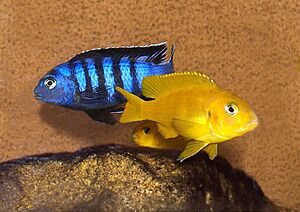Pseudotropheus saulosi facts for kids
Quick facts for kids Pseudotropheus saulosi |
|
|---|---|
 |
|
| male (blue and black) and female (yellow) | |
| Conservation status | |
| Scientific classification | |
| Synonyms | |
|
Chindongo saulosi (Konings, 1990) |
The Pseudotropheus saulosi is a type of cichlid fish. It lives only in Lake Malawi in East Africa. This fish prefers areas with lots of rocks. It is known as a dwarf-mbuna, which is a group of cichlids that live among rocks.
A scientist named Ad Konings first described this fish in 1990. He named it saulosi to honor Saulos Mwale. Saulos Mwale helped collect many of these fish for study. The Pseudotropheus saulosi comes only from a part of Lake Malawi called Taiwan Reef. You can also find this fish in aquariums.
What Does It Look Like?
This fish can grow to about 8.6 centimeters (3.4 inches) long. When they are born, all Pseudotropheus saulosi fish are yellow. As they grow up, the males change color. Adult males become bright blue with several black stripes.
Some younger or less dominant males might stay a paler blue. It's even possible for some young males to keep their yellow color. They can look just like the females. If the main male leaves a group, one of these hidden males might change color and become the new leader.
Reproduction and Life Cycle
Pseudotropheus saulosi females are "mouthbrooders." This means the mother carries her eggs in her mouth. She keeps them safe there until the baby fish, called fry, are ready to swim on their own. This usually takes about 13 to 18 days.
Why Is It Endangered?
Sadly, the Pseudotropheus saulosi is in great danger in the wild. It is listed as "Critically Endangered." This means there are very few of them left in their natural home. People are working hard to help these fish. They are trying to put fish bred in aquariums back into Taiwan Reef. This helps to increase their numbers in the wild.
See also
- List of freshwater aquarium fish species


